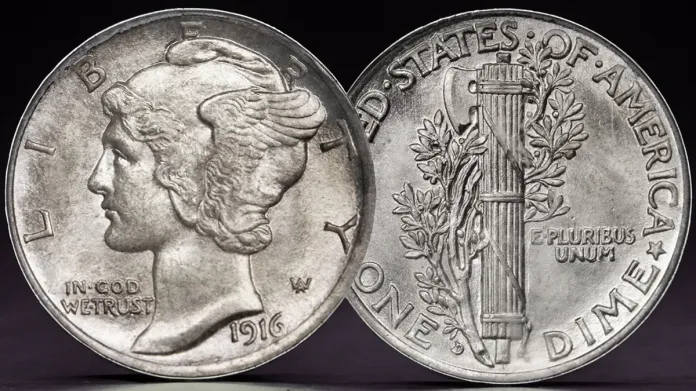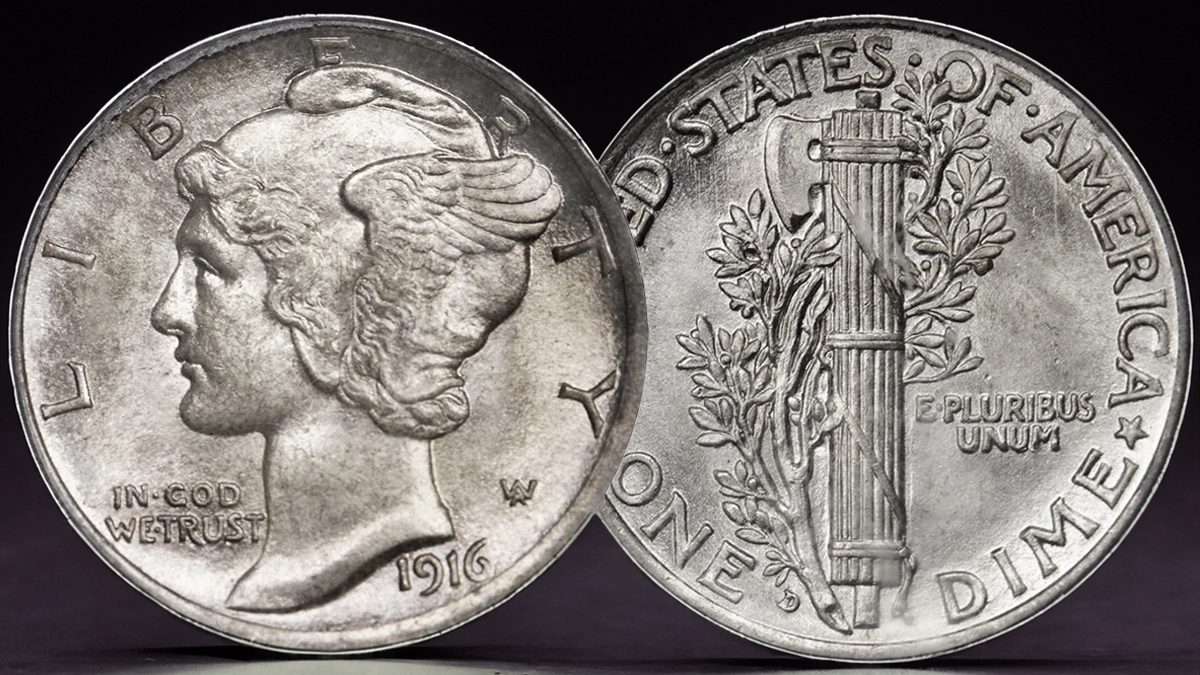
By Charles Morgan and Hubert Walker for CoinWeek Notes …..
The 1916-D Mercury Dime is a scarce key date coin from the first year of issue of an iconic American coin series that ran for almost 30 years. The Mercury or Winged Liberty Dime’s elegant design draws heavily from the French Beaux Arts movement of the late 19th century. Its release immediately preceded the Roosevelt Dime (1946-Present), and it is the last dime struck by the United States Mint entirely in .900 silver.
In the year of the coin’s initial release, Americans were introduced to three iconic U.S. coin designs. The other two were the Walking Liberty Half Dollar (also designed by Adolph Weinman and the basis of the American Silver Eagle bullion coin’s obverse design) and the Standing Liberty Quarter (designed by Massachusetts-based sculptor Hermon Atkins MacNeil). These coins joined the Indian Head (Buffalo) Nickel, the Lincoln Wheat Cent, the Indian Head $2.50 Quarter Eagle and $5 Half Eagle by Bela Lyon Pratt, and the Saint-Gaudens $10 Eagle and $20 Double Eagle gold coins.
A Brief History of the Mercury Dime
The original Winged Liberty Dime entered circulation at the end of October 1916 and remained in production for nearly 30 years.
Heralded for its beauty, the Winged Liberty Dime, often called the Mercury Dime due to its classically-inspired headgear, saw the country through World Wars and the Great Depression. Its unmistakable design was attached to the March of Dimes anti-polio campaign and countless Charles Atlas advertisements in the back of comic books and magazines. When “Yip” Harburg wrote the song “Brother, Can You Spare a Dime?” (1932), it was the Mercury Dime he was talking about.
The dime’s use in circulation carried on without incident. The design didn’t have the striking problems of the Buffalo Nickel or the Walking Liberty Half. Although specialists might seek out perfectly struck examples with Full Split Bands on the reverse (scarce for some issues), the Mercury Dime is remembered as an elegant and practical coin, a successful coin that served its purpose and elevated the image of American money.
The Mercury Dime’s term of service came to an unexpected end when President Franklin Delano Roosevelt died on April 12, 1945. A transformative president, FDR worked alongside allies to defeat the Axis powers in World War II. He established a social safety net for millions of Americans after a debilitating global depression and established a system of income distribution that created the vibrant American middle class that ushered in a prolonged period of postwar economic prosperity. Americans greeted his loss with shock and despair; his funeral tour was reminiscent of the one undertaken 80 years earlier after the traumatic death of Abraham Lincoln.
Almost immediately, a movement began to honor Roosevelt on a circulating coin. The dime was the obvious choice as the denomination recalled Franklin’s battle with polio and his work with the March of Dimes. On May 17, Henry Morgenthau, Jr., who served as Treasury Secretary under Presidents Roosevelt and Truman, announced that the Winged Liberty Dime design would be replaced by a new design featuring the portrait of the late president. The Roosevelt Dime was expected to debut at the end of the year, but the new dime was not released until 1946.
So with that, the stellar 30-year run of the Winged Liberty Dime ended. Steadily, the coins in circulation wore down, Mint State examples were hoarded, rare dates and varieties were cherrypicked, and by the time silver coins exited the scene in the mid-to-late 1960s, only the most worn examples continued to circulate.
Untold tens of thousands of original Mercury Dimes, including, unfortunately, some scarce dates, were melted in the silver run-up of the early 1980s. While several conditional rarities exist, the series is generally remembered for two key dates: the 1916-D and the scarce 1942/1941 overdate.
Why Is the 1916-D so Scarce?
The Mercury Dime was produced in quantity in 1916, with 22,180,080 struck at Philadelphia, and 10,450,000 struck at San Francisco. In light of those numbers, Denver’s output of 264,000 is puzzling.
Numismatists have speculated for years that the Denver Mint halted production of the new dime design shortly after an initial production run to devote resources to the production of quarters. Q. David Bowers notes that the first delivery of 1916-D Mercury Dimes took place on December 29, which means that the 1916-dated dime did not enter into circulation until 1917.
But the coin did circulate, as evidenced by the number of well-worn examples in the marketplace. Mint-state examples are rare, with choice examples bringing over $12,000 in today’s market. Gems and examples with Full Bands are even more challenging. A nicely toned MS67FB with CAC approval brought a record price of $207,000 in an August 2010 Heritage auction.
As this is one of the most counterfeited U.S. coins (see Jack Young’s recent piece), it is highly recommended that collectors buy only certified examples, even in grades as low as AG-03. Most fakes are accomplished by adding a “D” mintmark to a genuine 1916 dime.
* * *
Market Data and Noteworthy Specimens
The MS67FB top population at NGC has increased from one in April 2024 to four as of this October update. Top pops at PCGS and CACG have remained the same.
Top Population: PCGS MS67+FB (1, 10/2024), NGC MS67FB (4, 10/2024), and CAC MS67FB (4:0 stickered:graded, 10/2024).
- PCGS MS67+FB #38634042: “The William Dominick Collection,” Heritage Auctions, April 2001, Lot 6208 – $128,800; “The Joshua II Collection of Mercury Dimes, #1 All-Time Finest Registry Set,” August 2010, Lot 4490 – $195,500. As PCGS MS67FB CAC #38634042. “The D. Brent Pogue Collection, Part VII,” Stack’s Bowers, March 20, 2020, Lot 7050 – $204,000. Fire red toning along the periphery with gold and green inner hue. Pogue novelty insert. Since this sale, the coin has been upgraded by one-half point.
- PCGS MS67FB #6545707: “The Burgess Lee Berlin, M.D., J.D. Collection of Important United States Rarities,” Heritage Auctions, January 4, 2018, Lot 4808 – $96,000. Apricot all over turnover with green and orange toning on the left periphery of the obverse.
- PCGS MS67FB #25683814: Heritage Auctions, August 12, 2015, Lot 4000 – $94,130.43. Pale peach toning with rim toning in rust and green.
- PCGS MS67FB CAC #06643835: Heritage Auctions, November 1, 2013, Lot 3563 – $152,750.
- NGC MS67FB #641463-001: Heritage Auctions, July 31, 2009, Lot 1074 – $97,750. Scattered orange and green toning.
* * *
1916-D Mercury Dime Design
Obverse:
Adolph A. Weinman’s design features Liberty (of Thought) facing to the left. A winged cap adorns her head, tufts of hair curl around the base of the cap on her forehead and behind her ear. A braid of hair wraps around the base of her neck. LIBERTY wraps around the top of the coin with letters spaced apart. The letters “E” and “R” are partially obstructed by Liberty’s cap.
The motto IN GOD WE TRUST is in the bottom left of the field
The designer’s monogram (a “W” surmounting an “A”) appears behind Liberty’s neck below and to the left of the “Y” in LIBERTY. The date 1916 appears below the bust truncation to the rear. A subtle basin creates a dish-like appearance in the field.
Reverse:
In the center of the reverse of the 1916-D Mercury Dime is the fasces, a symbol of governmental authority originally used by the ancient Romans. An axe blade faces to the left. A curvilinear branch of olive leaves wraps behind the fasces. Wrapping around the top of the design is the legend UNITED · STATES · OF · AMERICA. Wrapping around the bottom of the design is the denomination ONE DIME. Two five-pointed stars separate the legend from the denomination. The D mint mark of the Denver Mint is located to the right of ONE. The motto E PLURIBUS UNUM (“Out of Many, One”) appears to the right of the fasces, slightly below center.
Edge:
The edge of the 1916-D Mercury Dime is reeded.
Designer
Adolph Alexander Weinman was born in Germany and immigrated to the United States as a teenager. He studied and worked under such famous American sculptors as Augustus Saint-Gaudens and Daniel Chester French. Weinman is responsible for two of the most iconic coin designs in U.S. history: the Mercury or Winged Liberty dime and the Walking Liberty half dollar, both of which debuted in the annus mirabilis numismaticus of 1916. Weinman’s sons also became sculptors and coin designers, and he taught such pupils as Anthony de Francisci. Adolph Weinman died in 1952.
Coin Specifications
| Country: | United States of America |
| Year of Issue: | 1916 |
| Denomination: | 10 Cents (USD) |
| Mintmark: | D (Denver) |
| Mintage: | 264,000 |
| Alloy: | .900 Fine Silver |
| Weight: | 2.50 g |
| Diameter: | 17.90 mm |
| Thickness: | 1.35 mm |
| Edge: | Reeded |
| OBV Designer: | Adolph A. Weinman |
| REV Designer: | Adolph A. Weinman |
| Quality: | Business Strike |
* * *


